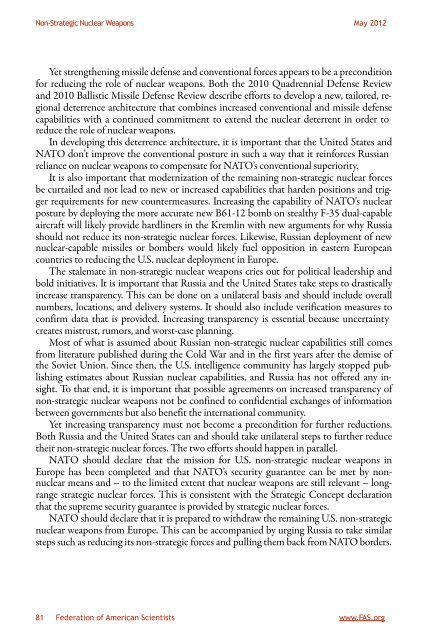Non Strategic Nuclear Weapons - Federation of American Scientists
Non Strategic Nuclear Weapons - Federation of American Scientists
Non Strategic Nuclear Weapons - Federation of American Scientists
You also want an ePaper? Increase the reach of your titles
YUMPU automatically turns print PDFs into web optimized ePapers that Google loves.
<strong>Non</strong>-<strong>Strategic</strong> <strong>Nuclear</strong> <strong>Weapons</strong> May 2012<br />
Yet strengthening missile defense and conventional forces appears to be a precondition<br />
for reducing the role <strong>of</strong> nuclear weapons. Both the 2010 Quadrennial Defense Review<br />
and 2010 Ballistic Missile Defense Review describe efforts to develop a new, tailored, regional<br />
deterrence architecture that combines increased conventional and missile defense<br />
capabilities with a continued commitment to extend the nuclear deterrent in order to<br />
reduce the role <strong>of</strong> nuclear weapons.<br />
In developing this deterrence architecture, it is important that the United States and<br />
NATO don’t improve the conventional posture in such a way that it reinforces Russian<br />
reliance on nuclear weapons to compensate for NATO’s conventional superiority.<br />
It is also important that modernization <strong>of</strong> the remaining non-strategic nuclear forces<br />
be curtailed and not lead to new or increased capabilities that harden positions and trigger<br />
requirements for new countermeasures. Increasing the capability <strong>of</strong> NATO's nuclear<br />
posture by deploying the more accurate new B61-12 bomb on stealthy F-35 dual-capable<br />
aircraft will likely provide hardliners in the Kremlin with new arguments for why Russia<br />
should not reduce its non-strategic nuclear forces. Likewise, Russian deployment <strong>of</strong> new<br />
nuclear-capable missiles or bombers would likely fuel opposition in eastern European<br />
countries to reducing the U.S. nuclear deployment in Europe.<br />
The stalemate in non-strategic nuclear weapons cries out for political leadership and<br />
bold initiatives. It is important that Russia and the United States take steps to drastically<br />
increase transparency. This can be done on a unilateral basis and should include overall<br />
numbers, locations, and delivery systems. It should also include verification measures to<br />
confirm data that is provided. Increasing transparency is essential because uncertainty<br />
creates mistrust, rumors, and worst-case planning.<br />
Most <strong>of</strong> what is assumed about Russian non-strategic nuclear capabilities still comes<br />
from literature published during the Cold War and in the first years after the demise <strong>of</strong><br />
the Soviet Union. Since then, the U.S. intelligence community has largely stopped publishing<br />
estimates about Russian nuclear capabilities, and Russia has not <strong>of</strong>fered any insight.<br />
To that end, it is important that possible agreements on increased transparency <strong>of</strong><br />
non-strategic nuclear weapons not be confined to confidential exchanges <strong>of</strong> information<br />
between governments but also benefit the international community.<br />
Yet increasing transparency must not become a precondition for further reductions.<br />
Both Russia and the United States can and should take unilateral steps to further reduce<br />
their non-strategic nuclear forces. The two efforts should happen in parallel.<br />
NATO should declare that the mission for U.S. non-strategic nuclear weapons in<br />
Europe has been completed and that NATO’s security guarantee can be met by nonnuclear<br />
means and – to the limited extent that nuclear weapons are still relevant – longrange<br />
strategic nuclear forces. This is consistent with the <strong>Strategic</strong> Concept declaration<br />
that the supreme security guarantee is provided by strategic nuclear forces.<br />
NATO should declare that it is prepared to withdraw the remaining U.S. non-strategic<br />
nuclear weapons from Europe. This can be accompanied by urging Russia to take similar<br />
steps such as reducing its non-strategic forces and pulling them back from NATO borders.<br />
81 <strong>Federation</strong> <strong>of</strong> <strong>American</strong> <strong>Scientists</strong> www.FAS.org
















